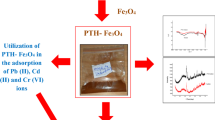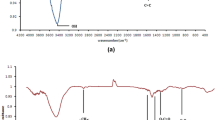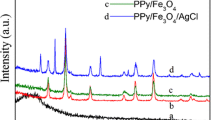Abstract
The purpose of this research work is to investigate the sorption characteristic of Polypyrrole/Fe3O4 (PPy/Fe3O4) nanocomposite (NC) for the removal of Ni(II) ions from aqueous solutions. The adsorbent was characterized using SEM, FTIR, and XRD. The SEM micrographs show the formation of PPy/Fe3O4 NC within 32–41 nm in size which has been homogeneously dispersed. The sorption of Ni(II) ions by a batch method was carried out and the optimum conditions were investigated. To determine the optimal conditions for adsorption, the effect of important parameters such as pH, contact time, initial concentration of Ni(II), amount of adsorbent, and temperature were investigated. Two models, Lagergren and pseudo-second order have been tested to track the kinetics of the removal process. Adherence of the adsorption process from pseudo-second-order kinetics and chemical adsorption was proved. The Langmuir and Freundlich were employed for the treatment of the equilibrium adsorption data and yielded a good fit with the Freundlich isotherm model. The PPy Fe3O4 NC has considerable Langmuir adsorption capacity to Ni(II) removal 250.0 mg/g. The adsorption process was exothermic with a negative value of ΔH° (− 21.9 kJ/mol) and spontaneous in nature (ΔG° = − 7.03 kJ/mol). The results have established the good potentiality of the Polypyrrole/Fe3O4 NC to remove Ni(II) from aqueous solutions.






Similar content being viewed by others
References
Gautam RK et al (2014) Biomass-derived biosorbents for metal ions sequestration: adsorbent modification and activation methods and adsorbent regeneration. J Environ Chem Eng 2(1):239–259
Pakade V, Monageng S, Tavengwa N (2016) Removal of Ni(II) Ions from aqueous solutions using ion imprinted polymer prepared from dual vinyl monomers. Asian J Sci Res 9(4):131–142
Es-sahbany H et al (2021) Investigation of the adsorption of heavy metals (Cu, Co, Ni and Pb) in treatment synthetic wastewater using natural clay as a potential adsorbent (Sale-Morocco). Materials Today: Proceedings.
Davidescu C-M et al (2013) Synthesis, characterization, and Ni(II) ion sorption properties of poly (styrene-co-divinylbenzene) functionalized with aminophosphonic acid groups. Polym Bull 70(1):277–291
Panneerselvam P, Morad N, Tan KA (2011) Magnetic nanoparticle (Fe3O4) impregnated onto tea waste for the removal of nickel(II) from aqueous solution. J Hazard Mater 186(1):160–168
Azamat J (2017) Removal of nickel(II) from aqueous solution by graphene and boron nitride nanosheets. J Water Environ Nanotechnol 2(1):26–33
Zhang X, Liu Y (2021) Concurrent removal of Cu(II), Co(II) and Ni(II) from wastewater by nanostructured layered sodium vanadosilicate: competitive adsorption kinetics and mechanisms. J Environ Chem Eng 9(5):105945
Lata H, Garg V, Gupta R (2008) Sequestration of nickel from aqueous solution onto activated carbon prepared from Parthenium hysterophorus L. J Hazard Mater 157(2–3):503–509
Kráčalíková K, Bleha M (2008) Chelating polymer-based membranes. Preparation and use for metal ion scavenging and sorption of murine immunoglobulin G by immobilized Ni(II) ions. Polym Bull 61(2):147–156. https://doi.org/10.1007/s00289-008-0940-8
Asri NS, Nurdila FA, Kato T, Iwata S, Suharyadi E (2018) Removal study of Cu(II), Fe(II) and Ni(II) ions from wastewater using polymer-coated cobalt ferrite (CoFe2O4) magnetic nanoparticles adsorbent. J Phys: Conf Series 1091:012016
Ayodele O et al (2021) Experimental and theoretical studies of the adsorption of Cu and Ni ions from wastewater by hydroxyapatite derived from eggshells. Environ Nanotechnol, Monitor Manage 15:100439
Raval NP, Shah PU, Shah NK (2016) Adsorptive removal of nickel(II) ions from aqueous environment: a review. J Environ Manage 179:1–20
Liakos EV et al (2021) Adsorption evaluation for the removal of nickel, mercury, and barium ions from single-component and mixtures of aqueous solutions by using an optimized biobased chitosan derivative. Polymers 13(2):232
Dao MU et al (2019) Adsorption of Ni(II) ions by magnetic activated carbon/chitosan beads prepared from spent coffee grounds, shrimp shells and green tea extract. Environmental technology.
Heidari A et al (2013) Selective adsorption of Pb(II), Cd(II), and Ni(II) ions from aqueous solution using chitosan–MAA nanoparticles. Int J Biol Macromol 61:251–263
Kursunlu AN et al (2009) Chemical modification of silica gel with synthesized new Schiff base derivatives and sorption studies of cobalt(II) and nickel(II). Appl Surf Sci 255(21):8798–8803
Kalavathy H, Karthik B, Miranda LR (2010) Removal and recovery of Ni and Zn from aqueous solution using activated carbon from Hevea brasiliensis: batch and column studies. Colloids Surf, B 78(2):291–302
Bartczak P et al (2018) Removal of nickel(II) and lead(II) ions from aqueous solution using peat as a low-cost adsorbent: a kinetic and equilibrium study. Arab J Chem 11(8):1209–1222
Alemayehu E, Lennartz B (2010) Adsorptive removal of nickel from water using volcanic rocks. Appl Geochem 25(10):1596–1602
Valderrama C et al (2010) Modelling of the Ni(II) removal from aqueous solutions onto grape stalk wastes in fixed-bed column. J Hazard Mater 174(1–3):144–150
Matouq M et al (2015) The adsorption kinetics and modeling for heavy metals removal from wastewater by Moringa pods. J Environ Chem Eng 3(2):775–784
Bui NT et al (2021) Superparamagnetic cobalt ferric nanoparticles incorporated biopolymers extracted from dragon fruit (hylocereus undatus) peels for nickel(II) removal. Environ Technol Innov 23:101773
Qadri S, Ganoe A, Haik Y (2009) Removal and recovery of acridine orange from solutions by use of magnetic nanoparticles. J Hazard Mater 169(1–3):318–323
Ahmad N et al (2019) New magnetic silica-based hybrid organic-inorganic nanocomposite for the removal of lead(II) and nickel(II) ions from aqueous solutions. Mater Chem Phys 226:73–81
Ansari R (2006) Polypyrrole conducting electroactive polymers: synthesis and stability studies. E-J Chem 3(4):186–201
Olad A, Ahmadi S, Rashidzadeh A (2013) Removal of Nickel(II) from aqueous solutions with polypyrrole modified clinoptilolite: kinetic and isotherm studies. Desalin Water Treat 51(37–39):7172–7180
Maity S, Dubey A, Chakraborty S (2019) A review on polypyrrole-coated bio-composites for the removal of heavy metal traces from waste water. J Ind Text 51:1528083719871272
Mahmud HNME, Huq AO, Binti Yahya R (2016) The removal of heavy metal ions from wastewater/aqueous solution using polypyrrole-based adsorbents: a review. Rsc Adv 6(18):14778–14791
Ghasemi M, Mashhadi S, Azimi-Amin J (2018) Fe3O4/AC nanocomposite as a novel nano adsorbent for effective removal of cationic dye: Process optimization based on Taguchi design method, kinetics, equilibrium and thermodynamics. J Water Environ Nanotechnol 3(4):321–336
Sharafinasab H, Ostovar F (2021) Evaluation of the Iron (III) oxide/sawdust nanocomposite efficiency in COD removal from landfill leachate: optimization and evaluation of adsorption isotherms. J Environ Res Technol 8(8):75
Nabiyouni G et al (2015) Room temperature synthesis and magnetic property studies of Fe3O4 nanoparticles prepared by a simple precipitation method. J Ind Eng Chem 21:599–603
Peng X et al (2015) Dedoped Fe3O4/PPy nanocomposite with high anti-interfering ability for effective separation of Ag(I) from mixed metal-ion solution. Chem Eng J 280:197–205
Yang R-B et al (2016) Synthesis and characterization of Fe3O4/polypyrrole/carbon nanotube composites with tunable microwave absorption properties: role of carbon nanotube and polypyrrole content. Chem Eng J 285:497–507
Li Y et al (2011) Facile synthesis, magnetic and microwave absorption properties of Fe3O4/polypyrrole core/shell nanocomposite. J Alloy Compd 509(10):4104–4107
Federation WE, Association A (2005) Standard methods for the examination of water and wastewater. American Public Health Association (APHA), Washington
Pourkarim S et al (2017) Adsorption of chromium (VI) from aqueous solution by Artist’s Bracket fungi. Sep Sci Technol 52(10):1733–1741
Ansari R, Hassanzadeh M, Ostovar F (2017) Arsenic Removal from Water Samples Using CeO2/Fe2O3 Nanocomposite. Int J Nanosci Nanotechnol 13(4):335–345
Silva V et al (2013) Synthesis and characterization of Fe3O4 nanoparticles coated with fucan polysaccharides. J Magn Magn Mater 343:138–143
Shrikrushna S, Kher JA, Kulkarni MV (2015) Influence of dodecylbenzene sulfonic acid doping on structural, morphological, electrical and optical properties on polypyrrole/3C-SiC nanocomposites. J Nanomed Nanotechnol 6(5):1
Vickers NJ (2017) Animal communication: when i’m calling you, will you answer too? Curr Biol 27(14):R713–R715
Karimi H et al (2008) Development of a selective and sensitive flotation method for determination of trace amounts of cobalt, nickel, copper and iron in environmental samples. J Hazard Mater 151(1):26–32
Leite AJ et al (2017) Activated carbon from avocado seeds for the removal of phenolic compounds from aqueous solutions. Desalin Water Treat 71:168–181
Esdaki Z, Ansari R and Ostovar F (2019) Removal of nickel(II) ions from aqueous solutions using iron (III) oxide nanoparticles: study of kinetic, isotherm and thermodynamic models. Iranian J Health Environ, 12(3).
Ulucan-Altuntas K, Debik E, Gungor S (2018) Nano zero-valent iron supported on activated carbon: effect of AC/nZVI ratio on removal of nickel ion from water. Global NEST J 20(2):424–431
Rajesh N et al (2011) Trialkylamine impregnated macroporous polymeric sorbent for the effective removal of chromium from industrial wastewater. J Chem Eng Data 56(5):2295–2304
Lagergren SK (1898) About the theory of so-called adsorption of soluble substances. Sven Vetenskapsakad Handingarl 24:1–39
Ho Y-S, McKay G (1999) Pseudo-second order model for sorption processes. Process Biochem 34(5):451–465
Ahmadi S et al (2019) The survey of application of the linear and nonlinear kinetic models for the adsorption of nickel(II) by modified multi-walled carbon nanotubes. Appl Water Sci 9(4):1–7
Ostovar F and Pourkarim S (2021) Application of walnut tree sawdust modified with KMnO4 for removal of methylene blue from aqueous solution in batch system: Isotherm, kinetic and thermodynamic studies.
Langmuir I (1918) The adsorption of gases on plane surfaces of glass, mica and platinum. J Am Chem Soc 40(9):1361–1403
Chakraborty S, Chowdhury S, Saha PD (2011) Adsorption of crystal violet from aqueous solution onto NaOH-modified rice husk. Carbohyd Polym 86(4):1533–1541
Freundlich H (1907) Über die adsorption in lösungen. Z Phys Chem 57(1):385–470
Ahmad A et al (2009) Removal of Cu(II) and Pb(II) ions from aqueous solutions by adsorption on sawdust of Meranti wood. Desalination 247(1–3):636–646
Bhaumik M et al (2011) Enhanced removal of Cr (VI) from aqueous solution using polypyrrole/Fe3O4 magnetic nanocomposite. J Hazard Mater 190(1–3):381–390
Huang C, Chung Y-C, Liou M-R (1996) Adsorption of Cu(II) and Ni(II) by pelletized biopolymer. J Hazard Mater 45(2–3):265–277
Hallaji H, Keshtkar AR, Moosavian MA (2015) A novel electrospun PVA/ZnO nanofiber adsorbent for U (VI), Cu(II) and Ni(II) removal from aqueous solution. J Taiwan Inst Chem Eng 46:109–118
Zhao X et al (2011) Adsorption of Cu(II), Pb(II), Co(II), Ni(II), and Cd(II) from aqueous solution by poly (aryl ether ketone) containing pendant carboxyl groups (PEK-L): equilibrium, kinetics, and thermodynamics. Chem Eng J 171(1):152–158
Abbas SH, Ali WH (2018) Evaluation of biomass type blue Cyanophyta algae for the sorption of Cr (III), Zn(II) and Ni(II) from aqueous solution using batch operation system: equilibrium, kinetic and thermodynamic studies. Global NEST J 20(1):69–82
Khaskheli M et al (2017) Competitive sorption of nickel, copper, lead and cadmium on okra leaves (Abelmoschus esculentus). Global Nest J 19(278):10.30955
Sharma Y, Srivastava V (2011) Comparative studies of removal of Cr (VI) and Ni(II) from aqueous solutions by magnetic nanoparticles. J Chem Eng Data 56(4):819–825
Khoshsang H et al (2018) Synthesis of mesoporous Fe3O4 and Fe3O4/C nanocomposite for removal of hazardous dye from aqueous media. J Water Environ Nanotechnol 3(3):191–206
Author information
Authors and Affiliations
Corresponding author
Additional information
Publisher's Note
Springer Nature remains neutral with regard to jurisdictional claims in published maps and institutional affiliations.
Rights and permissions
Springer Nature or its licensor holds exclusive rights to this article under a publishing agreement with the author(s) or other rightsholder(s); author self-archiving of the accepted manuscript version of this article is solely governed by the terms of such publishing agreement and applicable law.
About this article
Cite this article
Ansari, R., Esdaki, Z. & Ostovar, F. Synthesis, characterization, and application of polypyrrole/Fe3O4 nanocomposite for removal of Ni(II) ions from water and wastewaters. Polym. Bull. 80, 9451–9464 (2023). https://doi.org/10.1007/s00289-022-04493-8
Received:
Revised:
Accepted:
Published:
Issue Date:
DOI: https://doi.org/10.1007/s00289-022-04493-8




